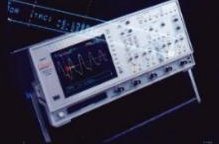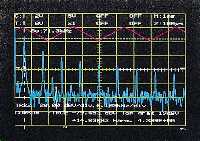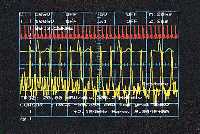Classic 6100
 |
Offering a 12-bit resolution mode as standard, the Classic 6100 will be of particular interest to users involved in analytical scientific research where the 6100's dynamic range guarantees that the complete signal is acquired - including the fine detail. The high resolution capability is achieved using a dither signal system that ensures low noise, linearity and accurate performance to give high quality data and thus meaningful information when the data is measured or analyzed. |
To ensure that data integrity is preserved, it is of paramount importance to avoid aliasing on high frequencies. The Classic 6100 has an Anti-Alias filter for each timebase, which removes high frequency noise beyond the maximum sample rate. With FFT Averaging, distortion 80 dB down from the fundamental can be observed.
Live separate variable zoom controls provide voltage ranges down to 62.5 µV per division. The high performance vertical resolution is engineered with no compromise, preserving 12-bit resolution over all timebase ranges and 10.8 ENOB (effective number of bits), even at high speed.
The high resolution mode is ideal for measuring large variations within signals such as engine pressures at different speeds or nerve responses in medical research.
The X-Y mode can be used in combination with analysis and measurements, for example displaying the B-H characteristics of magnetic materials. By subsequently measuring the enclosed display area using the specialized custom measurements, reading of flux can be obtained in the required engineering units.
The analysis and measurement system makes full use of the 12-bit resolution. Specialized measurements can be constructed to meet the user's precise application; for example automatically measuring system power over specific areas of the waveform using an exact number of cycles.
 |
The Fast Fourier Transform (FFT) shown indicates that the noise floor is 79 dBV down from the fundamental, clearly showing harmonic detail. The high resolution mode incorporates an anti alias-filter set appropriately on each timebase range to prevent misleading harmonics appearing in the analysis due to sample distortion of the high frequency content. FFT's run live and automatic measurements can be made selecting specified harmonics. |
Also included in the analysis option (121) are differentiation, integration, histogram and graphing functions. Histograms and graphs are used to evaluate performance over a time period by indicating variations and trends of measurements made on the waveforms as they occur.
|
The Classic 6100 with its dual mode of operation provides the flexibility to tackle design and research problems where both high resolution timing or high resolution amplitude analysis of waveforms is required. High resolution voltage capture is ideal for analytical scientific research where its wide dynamic range ensures that the complete signal is acquired - including the fine detail - for in-depth analysis. When tests are one-off events and the maximum signal is unknown, using a wider dynamic range allows the signal to be captured without missing essential small aberrations. |
 |
Measurements are made using the full resolution in both time and voltage. The Custom Measurement option also allows the customization of measurements including input scaling and calculations made in the required engineering units.
The range of mass storage options allows for manual or automatic capture of data that can be copied or transferred to a PC by disk or memory card for further analysis.
In-built plotters give instant records of waveforms or setups or, using the Gould software package Transition 2, full instrument data is quickly transferred into the PC via an appropriate interface where it is stored or incorporated into Microsoft Word® or Excel® documents for compiling reports.
Updated 3 June 1998
